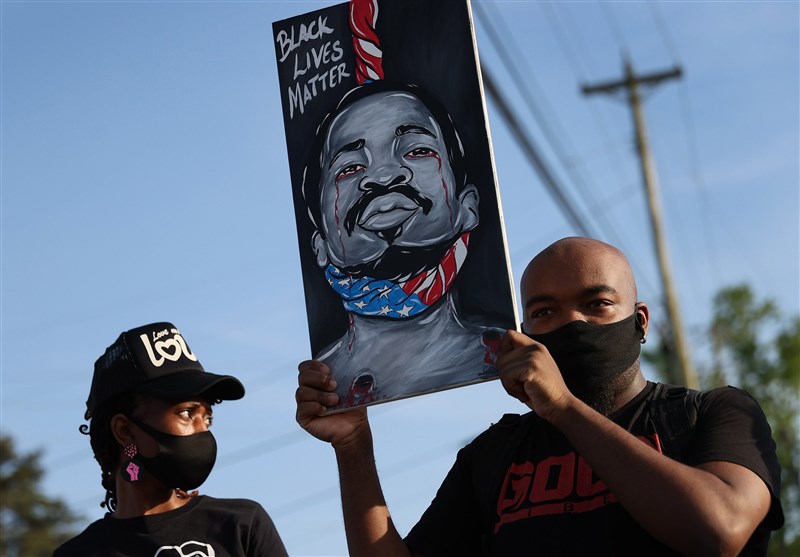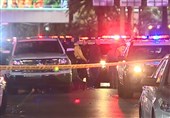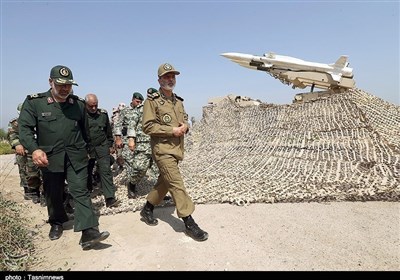Andrew Brown Jr.'s Lawyers Say New Video Shows Deadly Shooting Was An 'Ambush'
TEHRAN (Tasnim) – More body camera video from North Carolina deputies who fatally shot Andrew Brown Jr. last month show that he was "ambushed" in a "massacre," and it is evidence that merits criminal charges against the deputies, attorneys for Brown's family said Tuesday.
The family and the attorneys said they watched six videos that totaled about 20 minutes, including dashboard video without audio and video from deputies' body cameras, Tuesday at the Pasquotank County Sheriff's Office.
"You should be outraged that in 2021 — 2021 — that a man be killed, gunned down by a firing squad," said Harry Daniels, a Brown family attorney. "I'll be damned just because they wear a shield, a badge that the killers should still walk free."
Brown, 42, a Black man, was killed April 21 in Elizabeth City as Pasquotank County sheriff's deputies sought to serve a warrant for his arrest on felony drug charges, authorities said. A search warrant affidavit accused Brown of selling cocaine, crack, meth and heroin.
After seeing the video Tuesday, Brown's oldest son, Khalil Ferebee, said his father "wasn't in the wrong at all."
"What's in the dark going to come to the light. ... He's going to get his justice, 'cause it wasn't even right," Ferebee said.
The district attorney has said officers fired only after Brown struck deputies twice with his vehicle. But his family's attorneys say the video is at odds with how law officials have framed the shooting.
Chance Lynch, an attorney for the family, said the video shows that deputies fired at Brown, prompting him to move his vehicle away from them. After the shooting, Brown's vehicle was riddled with bullet holes, Lynch said.
"We counted approximately six, if not more, bullet holes in the side of his car ... And we were able to see a number of shots, approximately six, at least, in the back windshield. At no point — let me be very clear — at no point did we see Mr. Brown pose a threat to the law enforcement officers that were there," Lynch said.
Brown, who appeared to be on a cellphone when deputies approached him in his vehicle, was "ambushed," Lynch said, adding that body camera video of the aftermath of the shooting shows that deputies found no weapons on Brown.
"You could see that he was not a threat. There was a shot fired. When the shot was fired, he put the car in reverse, putting several feet, if not yards, away from the police who were there. He turned his wheel to the left, to turn it away from the law enforcement officers," he said. "At no point did we ever see any police officers behind his vehicle. At no point did we ever see Mr. Brown make contact with law enforcement."
Brown then began to accelerate across his yard when officers again began to shoot at the vehicle, Lynch said. The vehicle went down a ditch and crashed into a tree, he said. Deputies pulled Brown from the vehicle and laid him face-first on the ground.
In court last month, District Attorney Andrew Womble said deputies were prompted to fire because Brown made contact with them both behind and in front of the vehicle.
"As it backs up, it does make contact with law enforcement officers," Womble said at the hearing. "At this point, the car is stationary. There is no movement, and officers are positioned around the car. The next movement of the car is forward. It is in the direction of law enforcement and makes contact with law enforcement. It is then and only then that you hear shots."
Brown's shooting has drawn national attention to the small, majority-Black city in the rural northeastern corner of North Carolina. And many residents — as well as nationally prominent civil rights leaders and lawyers — have demanded the full release of the video over concerns that the shooting was unjustified and that Brown was "executed."
On April 26, Brown's family said they were shown 20 seconds of deputies' bodycam video, which appeared to show Brown with his hands on the steering wheel before he was killed.
Brown's family has said that even in the 20-second video, it was clear that he was not a threat to law enforcement.
Superior Court Judge Jeff Foster ruled last month that video from four deputies' body cameras would not be released to the public yet, but he said Brown's relatives and their attorney would be able to view it within 10 days. It took him until Thursday to issue a written ruling, which said the 10-day time period began then.
Foster ordered Pasquotank County Sheriff Tommy Wooten to blur faces or name tags of deputies involved before showing video to Brown's family. The ruling limited Brown's family to viewing less than 20 minutes of video.
Wooten said in a video statement Tuesday that it was his "hope that we would be able to release the video publicly, so everyone could see for themselves what happened."
"We respect the court's decision and took an oath to abide by North Carolina law," he said.
Chief Deputy Daniel Fogg said the sheriff's office "will continue to be as transparent as the law allows as we await results from the independent investigation."
The FBI said last month that it would open a federal civil rights investigation.
In many states, law enforcement video, such as body- or dash-cam video, is considered a public record, creating a defined, simple path for it to be released publicly. But North Carolina requires a judge's orderto allow the release of such video.
Brown's family commissioned a forensic pathologist, Dr. Brent Hall, who found that Brown was shot four times in the right arm and once squarely in the back of his head.
The shot to the head was fired from "intermediate" range and penetrated Brown's skull and brain, said Hall, who is based in Boone, North Carolina.
Another of the family's attorneys, Bakari Sellers, called for Womble to recuse himself because of the "incestuous relationship between the district attorney and law enforcement."
"We are going to raise a lot of hell and a lot of noise about the fact that Womble wants to stay on this case," Sellers said. "And if he chooses to stay on this case, we're going to ask him to make sure that he follows through with prosecuting the officers that murdered Andrew Brown."
Womble did not immediately respond to inquiries for comment Tuesday night about calls to recuse himself.
Late last month, Wooten, the sheriff, identified 10 deputies who converged on Brown's home to arrest him. Three who fired shots will remain on administrative leave as the matter is investigated, he said.
Four other deputies had been put on leave, but they were returned to active duty. Wooten also identified three other deputies who were at the scene and have left the force. A spokesperson for the sheriff's office has said their resignations were unrelated to the shooting.
NBC News reported last month that sheriff's department policy says shooting at moving vehicles is "rarely effective" and should be only a last resort to avoid an "imminent threat."
"Shots fired at or from a moving vehicle involve additional considerations and risks, and are rarely effective," says the policy, which is dated April 9 and was uploaded to the county's website.






